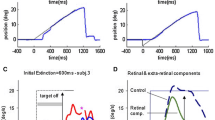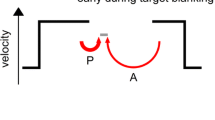Abstract
To determine if patients with Parkinson’s disease (PD) are able to use a visual contextual cue to induce a predictive change in smooth pursuit direction and if this ability depends on the state of the dopaminergic system, we measured predictive smooth pursuit in nine patients with mild to moderate PD during OFF and ON medication. These values were compared with those of nine agematched and sex-matched healthy controls.
Our focus was on the horizontal smooth pursuit when subjects pursued a downward moving target entering a ± 90 deg curve. The target moved on a homogeneous background or on a static “street” that indicated the future trajectory of the target. Our main result is that PD patients were impaired in eliciting predictive smooth pursuit using the context information of the street compared to healthy subjects. The control group elicited predictive pursuit 250 ms before target onset. In contrast, PD patients showed significantly longer latency (100–120 ms) and reduced maximal pursuit velocity. However, without the street guiding pursuit, a delay of about 250 ms was seen in both groups. There was no significant difference in the smooth pursuit performance between OFF and ON medication in the patient group.
These results show that earlystage PD patients are impaired in the use of static visual information as a cue for predictive pursuit compared to controls and that this deficit does not depend on dopaminergic medication. In the context of predictive eye movement, the involvement of the striatal-frontal pathway and the spatial working memory is discussed.
Similar content being viewed by others
References
Bloxham CA, Mindel TA, Frith CD (1984) Initiation and execution of predictable and unpredictable movements in Parkinson’s disease. Brain 107(Pt 2):371–384
Crawford TJ, Henderson L, Kennard C (1989) Abnormalities of nonvisuallyguided eye movements in Parkinson’s disease. Brain 112(Pt 6):1573–1586
Barnes GR, Donelan SF (1999) The remembered pursuit task: evidence for segregation of timing and velocity storage in predictive oculomotor control. Exp Brain Res 129(1):57–67
Hughes AJ, Daniel SE, Kilford L, Lees AJ (1992) Accuracy of clinical diagnosis of idiopathic Parkinson’s disease: a clinico-pathological study of 100 cases. J Neurol Neurosurg Psychiatry 55:181–184
Reimer J, Grabowski M, Lindvall O, Hagell P (2004) Use and interpretation of on/off diaries in Parkinson’s disease. J Neurol Neurosurg Psychiatry 75(3):396–400
Jankovic J, McDermott M, Carter J, et al. (1990) Variable expression of Parkinson’s disease: a base-line analysis of the DATATOP cohort. The Parkinson Study Group. Neurology 40(10):1529–1534
Fahn S, Elton RL (1987) Members of the UPDRS Development Committee. Unified Parkinson’s disease rating scale. In: Fahn S, Marsden CD, Calne DB, Goldstein M (eds) Recent developments in Parkinson’s disease. Mac Millan Healthcare Information; vol. 2, Florham Park: pp 153–163
Schneider E, Bartl K, Bardins S, Dera T, Boening G, Brandt T (2005) Eye movement driven head-mounted camera: It looks where the eyes look. IEEE International Conference on Systems, Man and Cybernetics 3:2437–2442
Dera T, Böning G, Bardins S, Schneider E (2006) Low-latency video tracking of horizontal, vertical, and torsional eye movements as a basis for 3DOF realtime motion control of a head-mounted camera. Procedures of the IEEE Conference on Systems, Man and Cybernetics, Taipei, Taiwan, October 7–12
Ladda J, Eggert T, Glasauer S, Straube A (2007) Velocity scaling of cue-induced smooth pursuit acceleration obeys constraints of natural motion. Exp Brain Res 182(3):343–356
Briand KA, Strallow D, Hening W, Poizner H, Sereno AB (1999) Control of voluntary and reflexive saccades in Parkinson’s disease. Exp Brain Res 129(1):38–48
Barnes GR, Asselman PT (1991) The mechanism of prediction in human smooth pursuit eye movements. J Physiol 439:439–461
Flowers KA, Downing AC (1978) Predictive control of eye movements in Parkinson disease. Ann Neurol 4(1):63–66
Lekwuwa GU, Barnes GR, Collins CJ, Limousin P (1999) Progressive bradykinesia and hypokinesia of ocular pursuit in Parkinson’s disease. J Neurol Neurosurg Psychiatry 66(6):746–753
Kowler E (1989) Cognitive expectations, not habits, control anticipatory smooth oculomotor pursuit. Vision Res 29:1049–1057
Hufschmidt A, Lucking CH (1995) Abnormalities of tracking behaviour in Parkinson’s Disease. Mov Disord 10(3):267–276
Rascol O, Clanet M, Montastruc JL, et al. (1989) Abnormal ocular movements in Parkinson’s disease. Evidence for involvement of dopaminergic systems. Brain 112(5):1193–1214
White OB, Saint-Cyr JA, Tomlinson RD, Sharpe JA (1938) Ocular motor deficits in Parkinson’s disease. II. Control of the saccadic and smooth pursuit systems. Brain 106(3):571–587
Collewijn H, Tamminga E (1984) Human smooth and saccadic eye movements during voluntary pursuit of different target motions on different backgrounds. J Physiol 351:217–250
Mohrmann H, Thier P (1995) The influence of structured visual backgrounds on smooth-pursuit initiation, steady-state pursuit and smooth-pursuit termination. Biol Cybern 73:83–93
Missal M, Heinen SJ (2004) Supplementary eye fields stimulation facilitates anticipatory pursuit. J Neurophysiol 92(2):1257–1262
Heinen SJ (1995) Single neuron activity in the dorsomedial frontal cortex during smooth pursuit eye movements. Exp Brain Res 104(2):357–361
Ilg UJ (2003) Visual-tracking neurons in area MST are activated during anticipatory pursuit eye movements. Neuroreport 14(17):2219–2223
Fukushima K, Yamanobe T, Shinmei Y, Fukushima J (2002) Predictive responses of periarcuate pursuit neurons to visual target motion. Exp Brain Res 145:104–120
Owen AM (2004) Cognitive dysfunction in Parkinson’s disease: the role of frontostriatal circuitry. Neuroscientist 10(6):525–537
Lewis SJ, Dove A, Robbins TW, Barker RA, Owen AM (2003) Cognitive impairments in early Parkinson’s disease are accompanied by reductions in activity in frontostriatal neural circuitry. J Neurosci 23(15):6351–6356
Basso MA, Pokorny JJ, Liu P (2005) Activity of substantia nigra pars reticulata neurons during smooth pursuit eye movements in monkeys. Eur J Neurosci 22(2):448–464
Goldman-Rakic PS (1998) The cortical dopamine system: role in memory and cognition. Adv Pharmacol 42:707–711
Muller U, von Cramon DY, Pollmann S (1998) D1- versus D2-receptor modulation of visuospatial working memory in humans. J Neurosci 18(7):2720–2728
Mattay VS, Tessitore A, Callicott JH, Bertolino A, et al. (2002) Dopaminergic modulation of cortical function in patients with Parkinson’s disease. Ann Neurol 51(2):156–164
Owen AM, James M, Leigh PN, Summers BA, et al. (1992) Fronto-striatal cognitive deficits at different stages of Parkinson’s disease. Brain 115(Pt 6):1727–1751
Rivaud S, Müri RM, Gaymard B, Vermersch AI, Pierrot-Deseilligny C (1994) Eye movement disorders after frontal eye field lesions in humans. Exp Brain Res 102(1):110–120
Keating EG (1991) Frontal eye field lesions impair predictive and visuallyguided pursuit eye movements. Exp Brain Res 86(2):311–323
Sharpe JA, Fletcher WA, Lang AE, Zackon DH (1987) Smooth pursuit during dose-related on-off fluctuations in Parkinson’s disease. Neurology 37:1389–1392
Waterston JA, Barnes GR, Grealy MA, Collins S (1996) Abnormalities of smooth eye and head control in Parkinson’s disease. Ann Neurol 39:749–760
Gibson JM, Kennard C (1986) Quantitative study of “on-off” fluctuations in the ocular motor system in Parkinson’s disease. Adv Neurol 45:329–333
Author information
Authors and Affiliations
Corresponding author
Additional information
J. Ladda and P. Valkovič contributed equally to this paper.
Rights and permissions
About this article
Cite this article
Ladda, J., Valkovič, P., Eggert, T. et al. Parkinsonian patients show impaired predictive smooth pursuit. J Neurol 255, 1071–1078 (2008). https://doi.org/10.1007/s00415-008-0852-4
Received:
Revised:
Accepted:
Published:
Issue Date:
DOI: https://doi.org/10.1007/s00415-008-0852-4




